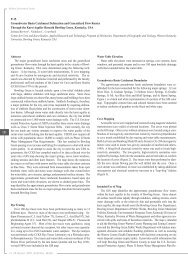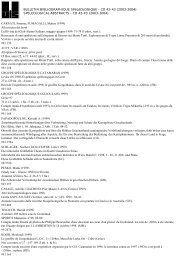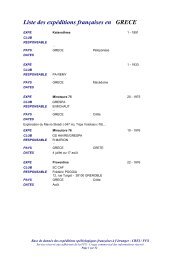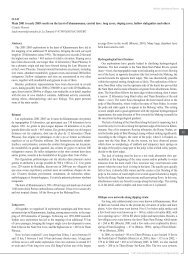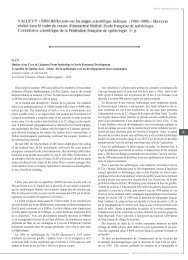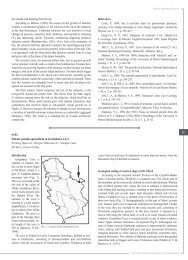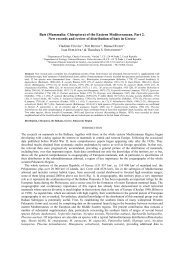Hypogene Speleogenesis
Hypogene Speleogenesis
Hypogene Speleogenesis
Create successful ePaper yourself
Turn your PDF publications into a flip-book with our unique Google optimized e-Paper software.
<strong>Hypogene</strong> <strong>Speleogenesis</strong><br />
and Karst Hydrogeology<br />
of Artesian Basins<br />
Ukrainian Institute of Speleology and Karstology<br />
Special Paper 1<br />
Edited by<br />
Alexander Klimchouk<br />
Derek Ford
<strong>Hypogene</strong> <strong>Speleogenesis</strong><br />
and Karst Hydrogeology<br />
of Artesian Basins<br />
Proceedings of the conference held May 13 through 17, 2009 in Chernivtsi, Ukraine<br />
Edited by<br />
Alexander B. Klimchouk and Derek C. Ford<br />
Ukrainian Institute of Speleology and Karstology<br />
Special Paper 1<br />
Simferopol<br />
2009
Ukrainian Institute of Speleology and Karstology, Ukraine<br />
Vernadsky Tavrichesky National University, Ukraine<br />
Fed’kovich Chernivtsy National University, Ukraine<br />
Institute of Geological Sciences, Ukraine<br />
National Cave and Karst Research Institute, USA<br />
Karst Water Institute, USA<br />
Silesian University, Poland<br />
Katowice Section of the Polish Geographic Society, Poland<br />
Ukrainian Speleological Association, Ukraine<br />
With support of:<br />
Union International of Speleology (UIS),<br />
UIS Commission on Karst Hydrogeology and <strong>Speleogenesis</strong><br />
International Geoscience Program 513<br />
“Global Study of Karst Aquifers and Water Resources” (UNESCO)<br />
International Year of Planet Earth (UNESCO-IUGS)<br />
Patronage Committee<br />
Bagrov N.V. – Rector of the Vernadsky Tavrichesky National University, corresponding member of the NASU<br />
Gozhik P.F. – Director of the Institute of Geological Sciences of NASU, corresponding member of NASU<br />
Mel'nichuk S.V. – Rector of the Fed'kovich Chertnivtsi National University, corresponding member of NASU<br />
Shelepnitsky I.O. – Head of the Chernivtsi Province Council<br />
Shestopalov V.M. – Academician-Secretary of the Department of Earth Sciences of NASU, academician of NASU<br />
Organizing Committee<br />
Klimchouk A.B. – UISK, Ukraine – Chairman<br />
Andrash V.V. – Ternopil' Speleo-Club "Podillya"<br />
Andreychuk V.N. – University of Silesia, Poland – UISK, Ukraine<br />
Apostoljuk V.A. – UISK – Ternopil' Speleo-Club "Podillya"<br />
Koptchinsky A. – Vienna University, Austria<br />
Rudenko V.P. – Fed'kovich Chernivtsy National University<br />
Ridush B.T. – UISK - Fed'kovich Chernivtsy National University<br />
Sokhatsky M.P. – UISK – Borshchiv Regional Museum<br />
Vakhrushev B.A. – UISK – Vernadsky Tavrichesky National University<br />
Zimel's J.L. – UISK – Ternopil' Speleo-Club "Podillya"<br />
Scientific Committee<br />
Shestopalov V. (NAS Ukraine) – Chairman<br />
Audra Ph. (University of Nice, France)<br />
Auler A. (Brazilian Institute for Karst and Caves, Brazil)<br />
Andrejchuk V. (University of Silesia, Poland – UISK, Ukraine)<br />
Dublyansky Yu. (Institut für Geologie und Paläontologie, Leopold-Franzens-Universität Innsbruck, Austria)<br />
Ford D. (McMaster University, Canada)<br />
Forti P. (University of Bologna, Italy)<br />
Frumkin A. (Jerusalem University, Israel)<br />
Kempe S. (University of Darmstadt, Germany)<br />
Klimchouk A. (UISK, Ukraine)<br />
Lowe D. (British Geological Survey, Nottingham, UK)<br />
Osborne A. (University of Sidney, Australia)<br />
Palmer A. (University of Oneonta, USA)<br />
Veni G. (National Cave and Karst Research Institute, USA)<br />
White W. (Pennsylvania State University)
CONTENTS<br />
PRINCIPAL FEATURES OF HYPOGENE SPELEOGENESIS 7<br />
Alexander Klimchouk<br />
HYPOGENE CAVE PATTERNS 17<br />
Philippe Audra, Ludovic Mocochain, Jean-Yves Bigot, and Jean-Claude Nobécourt<br />
MORPHOLOGICAL INDICATORS OF SPELEOGENESIS: HYPOGENIC SPELEOGENS 23<br />
Philippe Audra, Ludovic Mocochain, Jean-Yves Bigot, and Jean-Claude Nobécourt<br />
HYPOGENE CAVES IN DEFORMED (FOLD BELT) STRATA: OBSERVATIONS FROM EASTERN AUSTRALIA<br />
AND CENTRAL EUROPE 33<br />
R.A.L. Osborne<br />
IDENTIFYING PALEO WATER-ROCK INTERACTION DURING HYDROTHERMAL KARSTIFICATION:<br />
A STABLE ISOTOPE APPROACH 45<br />
Yuri Dublyansky and Christoph Spötl<br />
MICROORGANISMS AS SPELEOGENETIC AGENTS: GEOCHEMICAL DIVERSITY BUT GEOMICROBIAL UNITY 51<br />
P.J.Boston, M.N. Spilde, D.E. Northup, M.D. Curry, L.A. Melim, and L. Rosales-Lagarde<br />
SIDERITE WEATHERING AS A REACTION CAUSING HYPOGENE SPELEOGENESIS:<br />
THE EXAMPLE OF THE IBERG/HARZ/GERMANY 59<br />
Stephan Kempe<br />
SIMULATING THE DEVELOPMENT OF SOLUTION CONDUITS IN HYPOGENE SETTINGS 61<br />
C. Rehrl, S. Birk, and A. B. Klimchouk<br />
EVOLUTION OF CAVES IN POROUS LIMESTONE BY MIXING CORROSION: A MODEL APPROACH 67<br />
Wolfgang Dreybrodt, Douchko Romanov , and Georg Kaufmann<br />
SPELEOGENESIS OF MEDITERRANEAN KARSTS: A MODELLING APPROACH BASED<br />
ON REALISTIC FRACTURE NETWORKS 75<br />
Antoine Lafare, Hervé Jourde, Véronique Leonardi, Séverin Pistre, andNathalie Dörfliger<br />
GIANT COLLAPSE STRUCTURES FORMED BY HYPOGENIC KARSTIFICATION:<br />
THE OBRUKS OF THE CENTRAL ANATOLIA, TURKEY 83<br />
C. Serdar Bayari, N. Nur Ozyurt, and Emrah Pekkans<br />
ON THE ROLE OF HYPOGENE SPELEOGENESIS IN SHAPING THE COASTAL ENDOKARST OF SOUTHERN MALLORCA<br />
(WESTERN MEDITERRANEAN) 91<br />
Joaquín Ginés, Angel Ginés, Joan J. Fornós, Antoni Merino and Francesc Gràcia<br />
HYPOGENE CAVES IN THE APENNINES (ITALY) 101<br />
Sandro Galdenzi<br />
STEGBACHGRABEN, A MINERALIZED HYPOGENE CAVE IN THE GROSSARL VALLEY, AUSTRIA 117<br />
Yuri Dublyansky, Christoph Spötl, and Christoph Steinbauer<br />
HYPOGENE CAVES IN AUSTRIA 121<br />
Lukas Plan, Christoph Spötl, Rudolf Pavuza, Yuri Dublyansky<br />
KRAUSHÖHLE: THE FIRST SULPHURIC ACID CAVE IN THE EASTERN ALPS (STYRIA, AUSTRIA) 129<br />
Lukas Plan, Jo De Waele, Philippe Audra, Antonio Rossi, and Christoph Spötl<br />
HYDROTHERMAL ORIGIN OF ZADLAŠKA JAMA, AN ANCIENT ALPINE CAVE IN THE JULIAN ALPS, SLOVENIA 131<br />
Martin Knez and Tadej Slabe<br />
ACTIVE HYPOGENE SPELEOGENESIS AND THE GROUNDWATER SYSTEMS AROUND THE EDGES<br />
OF ANTICLINAL RIDGES 137<br />
Amos Frumkin<br />
SEISMIC-SAG STRUCTURAL SYSTEMS IN TERTIARY CARBONATE ROCKS BENEATH SOUTHEASTERN FLORIDA, USA:<br />
EVIDENCE FOR HYPOGENIC SPELEOGENESIS? 151<br />
Kevin J. Cunningham and Cameron Walker<br />
HYPOGENE SPELEOGENESIS IN THE PIEDMONT CRIMEA RANGE 159<br />
A.B. Klimchouk, E.I. Tymokhina and G.N. Amelichev
STYLES OF HYPOGENE CAVE DEVELOPMENT IN ANCIENT CARBONATE AREAS OVERLYING NON-PERMEABLE ROCKS<br />
IN BRAZIL AND THE INFLUENCE OF COMPETING MECHANISMS AND LATER MODIFYING PROCESSES 173<br />
Augusto S. Auler<br />
MORPHOLOGY AND GENESIS OF THE MAIN ORE BODY AT NANISIVIK ZINC/LEAD MINE, BAFFIN ISLAND, CANADA:<br />
AN OUTSTANDING EXAMPLE OF PARAGENETIC DISSOLUTION OF CARBONATE BEDROCKS WITH<br />
PENE-CONTEMPORANEOUS PRECIPITATION OF SULFIDES AND GANGUE MINERALS IN A HYPOGENE SETTING 181<br />
Derek Ford<br />
THE INFLUENCE OF HYPOGENE AND EPIGENE SPELEOGENESIS IN THE EVOLUTION<br />
OF THE VAZANTE KARST MINAS GERAIS STATE, BRAZIL 193<br />
Cristian Bittencourt, Augusto Sarreiro Auler, José Manoel dos Reis Neto, Vanio de Bessa and Marcus Vinícios Andrade Silva<br />
HYPOGENIC ASCENDING SPELEOGENESIS IN THE KRAKÓW-CZĘSTOCHOWA UPLAND (POLAND)<br />
– EVIDENCE IN CAVE MORPHOLOGY AND SURFACE RELIEF 201<br />
Andrzej Tyc<br />
EVIDENCE FROM CERNA VALLEY CAVES (SW ROMANIA) FOR SULFURIC ACID SPELEOGENESIS:<br />
A MINERALOGICAL AND STABLE ISOTOPE STUDY 209<br />
Bogdan P. Onac, Jonathan Sumrall, Jonathan Wynn, Tudor Tamas, Veronica Dărmiceanu and Cristina Cizmaş<br />
THE POSSIBILITY OF REVERSE FLOW PIRACY IN CAVES OF THE APPALACHIAN MOUNTAIN BELT 211<br />
Ira D. Sasowsky<br />
KARSTOGENESIS AT THE PRUT RIVER VALLEY (WESTERN UKRAINE, PRUT AREA) 213<br />
Viacheslav Andreychouk and Bogdan Ridush<br />
ZOLOUSHKA CAVE: HYPOGENE SPELEOGENESIS OR REVERSE WATER THROUGHFLOW? 221<br />
V. Коrzhyk<br />
EPIGENE AND HYPOGENE CAVES IN THE NEOGENE GYPSUM OF THE PONIDZIE AREA<br />
(NIECKA NIDZIAŃSKA REGION), POLAND 223<br />
Jan Urban, Viacheslav Andreychouk, and Andrzej Kasza<br />
PETRALONA CAVE: MORPHOLOGICAL ANALYSIS AND A NEW PERSPECTIVE ON ITS SPELEOGENESIS 233<br />
Georgios Lazaridis<br />
HYPOGENE SPELEOGENESIS IN MAINLAND NORWAY AND SVALBARD? 241<br />
Stein-Erik Lauritzen<br />
VILLA LUZ PARK CAVES: SPELEOGENESIS BASED ON CURRENT STRATIGRAPHIC AND MORPHOLOGIC EVIDENCE 245<br />
Laura Rosales-Lagarde, Penelope J. Boston, Andrew Campbell, and Mike Pullin<br />
HYPOGENE KARSTIFICATION IN SAUDI ARABIA (LAYLA LAKE SINKHOLES, AIN HEETH CAVE) 247<br />
Stephan Kempe, Heiko Dirks, and Ingo Bauer<br />
HYPOGENE KARSTIFICATION IN JORDAN (BERGISH/AL-DAHER CAVE, UWAIYED CAVE, BEER AL-MALABEH SINKHOLE) 253<br />
Stephan Kempe, Ahmad Al-Malabeh, and Horst-Volker Henschel<br />
ASSESSING THE RELIABILITY OF 2D RESISTIVITY IMAGING TO MAP A DEEP AQUIFER<br />
IN CARBONATE ROCKS IN THE IRAQI KURDISTAN REGION 257<br />
Bakhtiar K. Aziz and Ezzaden N. Baban<br />
FEATURES OF GEOLOGICAL CONDITIONS OF THE ORDINSKAYA UNDERWATER CAVE, FORE-URALS, RUSSIA 267<br />
Pavel Sivinskih<br />
ОСОБЕННОСТИ ГИПОГЕННОГО СПЕЛЕОГЕНЕЗА ГОРНО-СКЛАДЧАТОЙ ОБЛАСТИ ЗАПАДНОГО КАВКАЗА 271<br />
Б.А.Вахрушев<br />
ГЛУБИННОЕ СТРОЕНИЕ ГИДРОГЕОСФЕРЫ: МОДЕЛЬ ВЕРТИКАЛЬНОЙ ЗОНАЛЬНОСТИ 277<br />
В.Н. Катаев<br />
РОЛЬ КАРСТА В ФОРМИРОВАНИИ СОЛЕНЫХ ВОД И РАССОЛОВ ОЛЕНЁКСКОГО БАССЕЙНА 287<br />
Александр Кононов, Сергей Алексеев, и Сергей Сухов
PETRALONA CAVE: MORPHOLOGICAL ANALYSIS<br />
AND A NEW PERSPECTIVE ON ITS SPELEOGENESIS<br />
Georgios Lazaridis<br />
Department of Geology, Aristotle University of Thessaloniki, geolaz@math.auth.gr<br />
ABSTRACT<br />
Petralona Cave is one of the most important caves in Greece, due to the abundant paleontological findings of Middle<br />
Pleistocene age.<br />
Is Petralona Cave a typical karst cave? For almost half a century it was considered to be so.. In the present study,<br />
a new view of the Petralona Cave speleogenesis is proposed. A brief description of the cave and an analysis of its<br />
morphology are given, based on micro- and meso-scale morphology of the passages as well as the horizontal pattern<br />
of the cave. Morphological parameters are also estimated. Discriminant analysis is used to separate caves formed in<br />
unconfined setting by those formed by transverse speleogenesis. Discriminant functions extracted from the analysis (for<br />
2-D and 3-D data) could be used to classify new cases.<br />
The present study introduces a new approach to the Petralona Cave speleogenesis, which is interpreted to be the<br />
result of transverse speleogenesis, based on cave morphology and the geological setting of the broader area.<br />
INTRODUCTION<br />
Petralona Cave is located in Chalkidiki, 55 km away<br />
from the city of Thessaloniki (Macedonia, Northern Greece).<br />
It is a show cave that was found accidentally in 1959 by<br />
the local people. Afterwards, a number of explorations by<br />
members of the Hellenic Speleological Society took place,<br />
most of them under the leadership of Ioannis and Anna<br />
Petrochilou (1964). In 1960, a well-preserved skull that is<br />
considered to be a transitional form from Homo erectus to<br />
Homo sapiens, as well as fossils from 22 species of large<br />
mammals, were found. The existence of two different faunas<br />
has been noted in the cave, of late Middle Pleistocene and<br />
of Late Pleistocene age. On the other hand transitional<br />
forms have been detected (TSOUKALA, 1989).<br />
The cave is developed in the late Jurassic limestone<br />
of Mt. Katsika, that overlies phylites and the granodiorite<br />
of Monopigado (Figure1). The limestone consists of two<br />
layers different in age. The lower one, of Kimmeridian age,<br />
is characterized by the presence of Cladocoropsis mirabilis<br />
and Clypeina jurassica. The upper layer is of Portlandian<br />
age with Parugonia sp. (CHRISTARAS, 1984). Both layers<br />
rest conformably on the underlying phylites. At the northwestern<br />
part of Mt. Katsika, an intrusion of Monopigado<br />
Granodiorite outcrops. Sediments of Neogene age cover<br />
the above-mentioned basement rocks.<br />
In the southern part of the mountain there are travertine<br />
deposits related to inactive springs. SYRIDES (1990) infers<br />
that the drainage of the limestone of Mt. Katsika is to the<br />
southern part the mountain where the boundary of the<br />
limestone and the overlying impermeable sediments is lower<br />
in altitude. Furthermore, thermal water has been found by<br />
a shallow borehole in sediments south of the Petralona.<br />
This borehole is referred as the “great artesian borehole”.<br />
The karst water is found to be of meteoric origin (based<br />
on oxygen-18 and deuterium), but labelled by components<br />
of deep-seated origin such as CO 2<br />
and trace elements<br />
(fluoride and boron among others). In other boreholes the<br />
water is found to be a mixture of both karst and porous<br />
(Neogene sediments) aquifer systems (LOHENERT AND<br />
PAPAKONSTANTINOU, 1988).<br />
Three different groups of groundwater have been<br />
identified in the broader Mt. Katsika region with: a)<br />
extremely high arsenic concentrations (1.6–1.9 mg/L)<br />
and high temperature (33–42 ◦C, geothermal wells); b)<br />
relatively high arsenic concentrations (>0.050 mg/L), lower<br />
temperatures and relatively high concentrations of major<br />
ions, iron and manganese; c) low arsenic concentrations.<br />
In the southern part of the area, in the coastal wells, the<br />
influence of seawater has been detected from the high<br />
values of conductivity (KOURAS et al., 2007). The origin of<br />
the arsenic concentration is geogenic.<br />
In the Epanomi area that is located in the broader<br />
Mt. Katsika region, a gas field was discovered in 1988 by<br />
the borehole Epanomi-1. The reservoir is composed of<br />
Mesozoic limestone that overlies granodiorite. Turbidites<br />
of Eocene-Lower Oligocene comprise the cap rock of the<br />
gas field.<br />
Speleologists described Petralona Cave as a typical<br />
karst example (a cave formed in an unconfined setting) for<br />
almost half a century, but its morphology can be interpreted<br />
as a result of transverse speleogenesis (present article).<br />
233<br />
HYPOGENE SPELEOGENESIS AND KARST HYDROGEOLOGY OF ARTESIAN BASINS<br />
Ukrainian Institute of Speleology and Karstology, Special Paper 1, 2009
Lazaridis<br />
Figure 1. Geological sketch-map and cross section of the broader area of Petralona Cave. The stratigraphical column of Epanomi-1<br />
borehole is added to the western part of the cross-section. (Based on I.G.M.E., 1978; I.G.S.R., 1969 and ROUSSOS, 1992).<br />
METHODOLOGY<br />
The horizontal pattern analysis of the cave follows<br />
PALMER (2000; 2005) in order to relate the cave pattern to<br />
its host aquifer. The micro- and mesoscale morphology is<br />
based on BÖGLI (1978), WHITE AND DEIKE (1989), LAURITZEN<br />
AND LUNDBERG (2000), LUNDBERG (2005). The geometrical<br />
distinction of caves, formed in unconfined or confined<br />
(including artesian, hydrothermal or hypogenic caves)<br />
setting follow KLIMCHOUK (2003, 2007), FORD (2000) and<br />
FORD AND WILLIAMS (2007). Morphological parameters such<br />
as cave length, area of cave, area of cave field (by the<br />
polygon method), passage density and areal coverage are<br />
estimated according to KLIMCHOUK (2003). In addition, the<br />
mean breadth and the length to mean breadth ratio were<br />
calculated (FRUMKIN AND FISCHHENDLER, 2005).<br />
To separate caves developed in confined and<br />
unconfined settings discriminant analysis (DA) has been<br />
chosen. This analysis is based on data that have been<br />
previously divided into two groups (HAMMER AND HARPER,<br />
2006). For this purpose raw data of these two categories<br />
given by KLIMCHOUK (2003: Table 1) are used. Their division<br />
is ideally based on independent evidence (e.g. based on<br />
morphology not morphometry). DA projects multivariate<br />
data onto a single axis that maximizes the separation<br />
234<br />
HYPOGENE SPELEOGENESIS AND KARST HYDROGEOLOGY OF ARTESIAN BASINS<br />
Ukrainian Institute of Speleology and Karstology, Special Paper 1, 2009
PETRALONA CAVE: MORPHOLOGICAL ANALYSIS AND A NEW PERSPECTIVE ON ITS SPELEOGENESIS<br />
between two given groups. This<br />
analysis assumes multivariate normality<br />
in order to achieve better results. PAST<br />
1.81 software (HAMMER et al., 2001)<br />
was used for the DA. Additionally, the<br />
equality of the multivariate means<br />
for the given groups was tested by<br />
Hotelling’s T-squared.<br />
Morphology of the Petralona Cave<br />
Petralona Cave (Figure 2) is mostly<br />
developed horizontally, covering an<br />
area of 11.688 m 2 , and with 2.795 m<br />
in total length. The longest passages<br />
of the cave are of NE-SW striking<br />
and connected with each other by<br />
secondary passages trending NW- Figure 2. Ground-plan of Petralona Cave (based on POULIANOS, 2007)<br />
SE. Considering the tectonic setting<br />
of the area (CHRISTARAS, 1984) and<br />
the orientation of the cave passages the cave is fracture<br />
guided (after BÖGLI, 1978). The bulk of the main passages<br />
are abruptly termianted. Based on its horizontal pattern,<br />
the cave should be defeined mainly as a ramiform maze.<br />
Vertical shafts in various places of the cave are noticeable,<br />
but vadose entrenchments are not observed in any of<br />
them.<br />
In the central area of the cave there are large chambers<br />
caused by breakdown. Breakdown morphology at the<br />
south-eastern chamber of the cave is characteristic due to<br />
a breakout dome and a cone of debris that are formed.<br />
Above the cone of debris there is a sediment-filled vertical<br />
passage (circular in cross-section) that is considered to be<br />
a probable closed (choked) entrance (TSOUKALA, 1989).<br />
Other micro-scale features (Plates 1 and 2) in the<br />
chamber and passage morphology are the following:<br />
pendants that are remnants from removal of intervening rock<br />
by eddy dissolution; walls sculptured by cupolas that grade<br />
downward into sloping sidewalls (facets); ceiling cupolas,<br />
feeders and half tubes (Plate 2). Usually, speleogens in the<br />
cave are covered by abundant speleothems.<br />
The cave decoration includes, besides the common<br />
speleothems (stalactites, stalagmites, columns, cave coral<br />
et.c.), a great variety of shields, helictites, gours, cave<br />
pearls, spar etc. A considerable occurrence of cave clouds<br />
on the ceiling of the cave is an indicator of phreatic stagnant<br />
water (Plate 1).<br />
The morphometric parameters of Petralona Cave are<br />
given in Table 1.<br />
Table 1<br />
Two-dimensional geometry of the Petralona Cave<br />
Length(km)<br />
Cave<br />
area(km2)<br />
Area of<br />
cave<br />
field(km2)<br />
Passage<br />
density(km/<br />
km2)<br />
volume of rock and of cave porosity is impossible. Thus,<br />
two-dimensional geometrical parameters have been used<br />
to discriminate these given groups as well as to classify<br />
Petralona Cave in a sample group. For the analysis<br />
all values are transformed to logarithms for log-normal<br />
distribution and better results. The sample of caves selected<br />
contains four cases of caves formed in unconfined settings<br />
and twenty-one in confined settings.<br />
The division of the two groups by the combination of<br />
passage density and areal coverage is acceptable for all<br />
cases used (100% both for original grouped cases correctly<br />
classified and for cross-validated grouped cases correctly<br />
classified). The null hypothesis that the multivariate means<br />
of the two sets are equal is rejected (p(same)= 8.6E-9,<br />
Hotelling’s T 2 ). Multivariate normality is equal to 0.961 and<br />
the prerequisite for equivalence of the covariance matrices<br />
holds good (Box’M: 2.0799, p(equal)=0.67). The resultant<br />
discriminant function V 1<br />
can be used for new cases, such<br />
as Petralona Cave:<br />
V 1<br />
= -20.054(log(passage density))-15.859(log(areal<br />
coverage))+51.5206<br />
Zero is used as a cut-off point, which means that<br />
negative scores will be calculated for caves formed in<br />
confined settings.<br />
When 3-dimensional data of cave geometry are<br />
available the variable of cave porosity is added in a<br />
second analysis; the following discriminant function is then<br />
extracted:<br />
V 2<br />
= -17.258(log(passage density)) -10.654(log(cave<br />
porosity)) -13.351(log(areal coverage))+44.7785<br />
Areal<br />
coverage(%)<br />
Mean<br />
breadth(Km)<br />
2.795 0.011688 0.032522 85.94 35.94 0.004182 668.34<br />
Length to<br />
mean breadth<br />
ratio<br />
DISCRIMINANT ANALYSIS<br />
Many cave maps are not accompanied by crosssections,<br />
including the Petralona Cave map. As a result,<br />
estimation of the volume of the cave, specific volume,<br />
Caves with negative scores are attributed to confined<br />
setting, as noted. The hypothesis that the two groups<br />
separated by V 2<br />
have equal multivariate means is rejected<br />
235<br />
HYPOGENE SPELEOGENESIS AND KARST HYDROGEOLOGY OF ARTESIAN BASINS<br />
Ukrainian Institute of Speleology and Karstology, Special Paper 1, 2009
Lazaridis<br />
Plate 1. Petralona Cave: A and B) cave clouds on cave walls and ceiling; C) cupolas connected upwards; D) walls sculptured by<br />
cupola that grade downward into sloping sidewalls.<br />
(p=1.03E-8). Equivalence of covariances cannot be<br />
rejected (Box’M: 5.6682, p(equal)=0.73), but multivariate<br />
normality is equal to 0.14. Although, v 2<br />
classifies well in<br />
100% of cases used for the analysis, it is considered to be<br />
less valid than v 1<br />
.<br />
APPLICATION OF V 1<br />
The discriminant function V 1<br />
was also used for the<br />
Maaras Cave (Greece) and the Frasassi Cave (Italy) in<br />
order to be tested. The former is a branchwork cave (the<br />
longest underground river of Greece) formed in unconfined<br />
setting, and the later is a ramiform cave (hypogenic). Both<br />
cases are classified correctly (Table 2).<br />
Petralona Cave has negative score for V 1<br />
equal to<br />
-11.94, which assigns its classification to caves formed by<br />
transverse speleogenesis in confined settings.<br />
New data added to DA and the resultant discriminant<br />
function V 1<br />
recalculated as<br />
V 3<br />
= -15,616(log(passage density))-20,102(log(areal<br />
coverage))+48,0915<br />
The sample of caves used for V 1<br />
consists mostly of<br />
network caves that present high values of passage density.<br />
The addition of ramifying caves results in a higher coefficient<br />
of areal coverage for the discriminant function V 3<br />
, than V . 1<br />
236<br />
HYPOGENE SPELEOGENESIS AND KARST HYDROGEOLOGY OF ARTESIAN BASINS<br />
Ukrainian Institute of Speleology and Karstology, Special Paper 1, 2009
PETRALONA CAVE: MORPHOLOGICAL ANALYSIS AND A NEW PERSPECTIVE ON ITS SPELEOGENESIS<br />
Plate 2. Petralona Cave: Meso-scale morphology A) sidewall feeder terminated upward in cupolas-like forms; B) a complex of small<br />
and larger cupolas on the ceiling; C) ceiling half-tube connected to cupolas; D) chain of cupolas. 1) feeder; 2) cupolas.<br />
DISCUSSION AND CONCLUSIONS<br />
Cave morphology is a strong tool to investigate<br />
cave history and speleogenesis. The morphology of the<br />
Petralona Cave can be summarized as follows: network<br />
horizontal pattern; fracture-guided passages; abruptly<br />
ended passages, vertical shafts formed in the phreatic<br />
zone (notible is a shaft in the NW part of the cave that<br />
ends at a ‘laügdecken’ at the top and appears to be a<br />
rising shaft, although little is known about these shafts),<br />
feeders, half tubes and small cupolas. The mixing of two<br />
waters of contrasting chemistry can result in a network<br />
pattern. Various parts of the cave resemble the ramiform<br />
pattern that is also usually the product of rising thermal<br />
water (PALMER, 2000). The horizontal pattern of the cave<br />
is strongly related to the permeability structure of the cave<br />
formation, which is common in caves formed by ascending<br />
water. In addition, blind terminations of cave passages are<br />
usually related to hypogene speleogenesis (KLIMCHOUK,<br />
2007). Feeders sculpted on cave walls, ceiling cupolas and<br />
half tubes, present in various places in Petralona Cave, are<br />
common in hypogenic caves.<br />
Cave clouds that occur on the ceiling of the cave is<br />
a speleothem found commonly in hypogenic caves. Cave<br />
cloud formation is usually developed in a shallow phreatic<br />
environment. This speleothem has been reported in caves<br />
formed by rising thermal water such as Devil’s Hole,<br />
Lechuguilla Cave, Carlsbad Caves, Giusti Cave etc. (HILL<br />
AND FORTI, 1997).<br />
237<br />
HYPOGENE SPELEOGENESIS AND KARST HYDROGEOLOGY OF ARTESIAN BASINS<br />
Ukrainian Institute of Speleology and Karstology, Special Paper 1, 2009
Lazaridis<br />
Table 2<br />
Two-dimensional morphometric parameters of caves used to test the validation of the discriminant function V 1<br />
;<br />
their horizontal pattern and the V 1<br />
-score.<br />
Cave Length(km) Cave area<br />
(km2)<br />
Area of cave<br />
field (km2)<br />
Passage<br />
density<br />
(km/km2)<br />
Areal<br />
coverage<br />
(%)<br />
Mean<br />
breadth<br />
(Km)<br />
Length<br />
to mean<br />
breadth ratio<br />
Horizontal pattern<br />
Score<br />
(V1)<br />
Maaras<br />
(Greece)<br />
Frasassi<br />
(Italy)<br />
9.444 0.346 2.704 3.49 12.79 0.0366 4916.71 Branchwork cave<br />
pattern(unconfined<br />
settting)<br />
13* 0.093 0.353 36.8 26.32 0.0072 1817.2 Ramiform cave<br />
pattern(hypogenic)<br />
(GALDENZI AND<br />
MARUOKA, 2003)<br />
23.07542<br />
-2.40346<br />
*According to the official site of the Frasassi Cave (www.frasassi.com, accessed on January 2009) GALDENZI AND MARUOKA (2003)<br />
refer >20 km cave length that gives score
PETRALONA CAVE: MORPHOLOGICAL ANALYSIS AND A NEW PERSPECTIVE ON ITS SPELEOGENESIS<br />
Palmer, A. N. 2005. Passage growth and development. In<br />
Encyclopedia of caves D.C. Culver and W.B. White (Eds.),<br />
Elsevier Inc. pp. 440-444.<br />
Petrochilou, A. 1964. The Kokkinon Petron Cave of Petralona,<br />
Chalkidiki (No 1044). Bulletin de la societé spéléologique de<br />
Gréce, 7:6, 157-167.<br />
Poulianos, N.A. 2007. The cave of the petralonian<br />
archanthropinae (8 th edition), ISBN 960-86804-3-3, 97 pp.<br />
Roussos, N. 1992. The gas field of Epanomi (Thessaloniki). An<br />
example of a fractured reservoir. Bull. Geol. Soc., 28:2, 507-523<br />
(in Greek with English abstract).<br />
Syrides, G. 1990. Lithostratigrahic biostraigraphic and<br />
paleogeographic study of the Neogene-Quaternary sedimentary<br />
deposits of Chakidiki Peninsula, Macedonia, Greece. Thesis,<br />
Scientific Annals, School of Geology, university of Thessaloniki,<br />
1:11, 243pp. (in Greek).<br />
Tsoukala, E., 1989, Contribution to the study of the Pleistocene<br />
fauna of large mammals (Carnivora, Perissodactyla, Artiodactyla)<br />
from the Petralona Cave (Chalkidiki, N. Greece). Thesis,<br />
Scientific Annals, School of Geology, university of Thessaloniki,<br />
1(8), 360pp. (in Greek).<br />
White, B. W., and Deike III, H. G. 1989. Hydraulic geometry of<br />
cave passages. In Karst Hydrology White, W. and White, E.<br />
(Eds.), Concepts from the Mammoth Cave Area, Van Nostrand<br />
Reinhold, pp. 223-258, New York.<br />
239<br />
HYPOGENE SPELEOGENESIS AND KARST HYDROGEOLOGY OF ARTESIAN BASINS<br />
Ukrainian Institute of Speleology and Karstology, Special Paper 1, 2009





